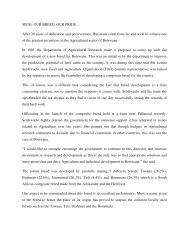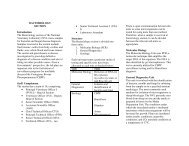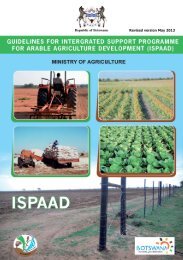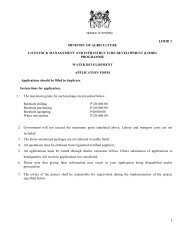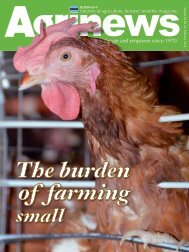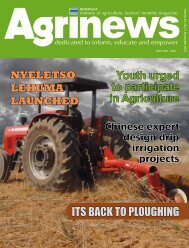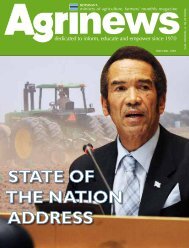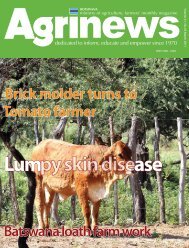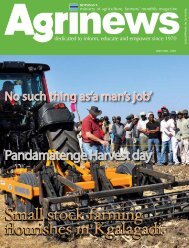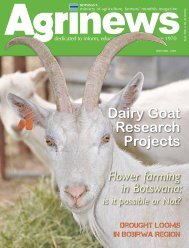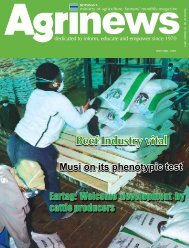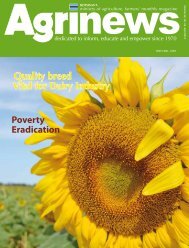Agrinews January 2013 - Ministry of Agriculture
Agrinews January 2013 - Ministry of Agriculture
Agrinews January 2013 - Ministry of Agriculture
You also want an ePaper? Increase the reach of your titles
YUMPU automatically turns print PDFs into web optimized ePapers that Google loves.
continued from page 12 5<br />
during drought years. Moreover, the<br />
use <strong>of</strong> adapted species and varieties,<br />
the adoption <strong>of</strong> dry land agriculture<br />
techniques in rain fed agriculture;<br />
farmers can also substantially<br />
improve and stabilize crop yields. In<br />
fact, many researchers have revealed<br />
in on-farm trials the importance <strong>of</strong><br />
minimum tillage (Kacemi, 1992),<br />
no-till (Bouzza, 1990) and mulching<br />
technologies. These techniques<br />
have also proved to be reducing<br />
evaporation, increase the interception<br />
<strong>of</strong> rain and its infiltration and insure<br />
the saving <strong>of</strong> water, energy and time,<br />
guarantee a long-term increase and<br />
increase the sequestration <strong>of</strong> carbon.<br />
It has also been observed that<br />
chemical fallowing (controlling <strong>of</strong><br />
weeds by the use <strong>of</strong> chemicals) can<br />
allow the conservation <strong>of</strong> between<br />
75 and 100 mm <strong>of</strong> water in the soil<br />
(Bouzza, 1990), which can be able to<br />
sustain some forage crops that require<br />
minimum moisture. In Botswana for<br />
example, some strategies employed<br />
to thwart the effects <strong>of</strong> the dry spells<br />
include among others storage <strong>of</strong><br />
crop harvests from good seasons and<br />
supplementary feeding (Mogotsi and<br />
Nyariki, 2011). However, the latter<br />
strategy can only be employed by<br />
those farmers who have the means<br />
(whose wealth is beyond reproach).<br />
BOTSWANA AFRICAN ARMY WORM (SEBOKO SA SEGOPA) MAP<br />
(AS AT 22/01/<strong>2013</strong>)<br />
#<br />
Gantsi<br />
#<br />
#<br />
NGAMILAND<br />
#<br />
Maun<br />
#<br />
#<br />
#<br />
#<br />
GHANZI<br />
#<br />
CHOBE<br />
Kasane<br />
#<br />
#<br />
Orapa<br />
#<br />
#<br />
#<br />
#<br />
Nata<br />
#<br />
#<br />
Serowe<br />
# #<br />
Tutume<br />
#<br />
#<br />
CENTRAL<br />
#<br />
#<br />
#<br />
Mahalapye<br />
CONCLUSION<br />
There are many strategies that can<br />
be employed to mitigate the menace<br />
effects <strong>of</strong> droughts as fore noted that<br />
can be chosen depending on the area<br />
affected. The bottom line is that the<br />
livestock species has to be saved in<br />
whatever circumstance the mitigation<br />
strategy would be geared to.<br />
Author: J.K. Mthetho<br />
Department <strong>of</strong> Animal Production<br />
Mochudi<br />
Tel: 5777075/288<br />
E-mail: jmthetho@gmail.com<br />
AFRICAN ARMYWORM ( SEBOKO SA SEGOPA ) OUTBREAK MAP ( AS AT 22/01/<strong>2013</strong> )<br />
N<br />
#<br />
## # #<br />
NORTH EAST<br />
# Francistown<br />
#<br />
Tonota<br />
##<br />
#<br />
#<br />
Bobonong<br />
# #<br />
Selebi Phikwe<br />
Palapye<br />
# #<br />
##<br />
#<br />
# #<br />
#<br />
#<br />
#<br />
Hiwa Moreki<br />
dedicated bean farmer<br />
Article & Photos: France Begensel<br />
Many small scale farmers across<br />
the country have not embraced<br />
the idea <strong>of</strong> specialising on one<br />
particular crop. Only a handful have<br />
seen the importance <strong>of</strong> that. Amongst<br />
such farmers is Hiwa Moreki, 55, <strong>of</strong><br />
Mokalaneng lands in Ngwaketse East<br />
near Magothwane village. Moreki, a<br />
bean farmer only worked for a few<br />
years as a driver in the Department<br />
<strong>of</strong> Water Affairs from 1981-1985. He<br />
then quit to focus his energies on<br />
dryland farming.<br />
Moreki learnt a lot by benchmarking<br />
in Pandamatenga, Musi lands and also<br />
visited prominent farmers like Kgosi<br />
Daniel Mathiba, Oarabile Dingalo,<br />
John Phirinyane and Mokwapa<br />
Ramusu. He adds that his experiences<br />
in farming have taught him that beans<br />
do well in Magothwane/Nhlanhle area,<br />
the reason he took it up.<br />
He also reveals that legume prices at<br />
the Botswana Agricultural marketing<br />
Board are very ecncouraging. The<br />
recent initiative by the <strong>Ministry</strong> <strong>of</strong> Local<br />
Government and Rural Development<br />
to have farmers supply primary schools<br />
with farm produce like mealies,<br />
watermelon and beans could also not<br />
have come at a better time. He states<br />
that this is motivation enough for one<br />
to produce on a large scale.<br />
With a 13,5 hectare field, Moreki<br />
decided to allocate 13,3 hecters to<br />
growing beans. He planted them in<br />
September unlike in the previous years<br />
where he took to the fields in November.<br />
This, he reveals has helped him a lot as<br />
he expects his first harvest mid <strong>January</strong>.<br />
He also posits that planting earlier is<br />
a blessing because by the time wild<br />
animals come to scavenge for food<br />
in the lands he would have already<br />
harvested. This also helps avoid crops<br />
suffering from heatstroke in <strong>January</strong> as<br />
it would be very hot.<br />
The former water affairs driver discloses<br />
that he used the ISPAAD programme.<br />
This he says helped him with fertilizers<br />
and ploughing. But as for seeds he<br />
bought them himself. He posits that<br />
the programme has helped him a lot<br />
and that on his own he could not have<br />
achieved anything.<br />
“I have planted the Black eye and<br />
Ramonnana varieties. This is because<br />
they do not take long to mature. And<br />
that you harvest the Black eye twice<br />
and the Ramonnana variety three times.”<br />
He adds that with these varieties one<br />
would always realise pr<strong>of</strong>it.<br />
Although Moreki decries the lack <strong>of</strong><br />
implements in farming, he always row<br />
plants. He says that it makes it easier<br />
to weed, harvest and to move around.<br />
He reveals that row planted crops<br />
are always healthy because they do<br />
not compete for water and nutrients.<br />
Moreki states that he used a planter he<br />
recently acquired and is not a model<br />
he is familiar with. He says that this<br />
resulted in uneven distribution and<br />
spread <strong>of</strong> both seeds and fertilizers<br />
but believes he would have acquinted<br />
himself to it in the next planting season.<br />
When harvesting is done, the crop<br />
residue is thrashed and fed to livestock<br />
and small stock. Nothing is thrown<br />
away, discloses Moreki. He says he<br />
sells these to farmers who come as far<br />
as Gantsi and Charleshill.<br />
As a small scale farmer, Moreki says<br />
he has learnt a lot from his farming<br />
experiences. He reveals that he has<br />
acquired a 170hectare field which<br />
he intends to use half for legume<br />
production and the remaining part for<br />
other crops like mealies, sorghum and<br />
water melons.<br />
Kang #<br />
KGALAGADI<br />
Tsabong<br />
#<br />
KWENENG<br />
#<br />
# # KGATLENG<br />
#<br />
#<br />
Molepolole<br />
Mochudi<br />
#<br />
#<br />
#<br />
Jwaneng #<br />
#<br />
#<br />
# #<br />
# #<br />
#<br />
# ##<br />
# # #<br />
# # # # # #<br />
SOUTHERN<br />
# # # # GABORONE<br />
Kanye # # Ramotswa<br />
# #<br />
# SOUTH EAST<br />
#<br />
#<br />
#<br />
# Lobatse<br />
# #<br />
# #<br />
# #<br />
#<br />
# #<br />
Legend<br />
# Confirmed African Army Worm Outbreak<br />
# Unconfirmed African Army Worm Outbreak<br />
# Major village<br />
Major river<br />
Main road<br />
District boundary<br />
Compiled by <strong>Ministry</strong> <strong>of</strong> <strong>Agriculture</strong> Gaborone, Botswana<br />
12 6<br />
13<br />
6<br />
<strong>January</strong> <strong>2013</strong> <strong>January</strong> <strong>2013</strong>



